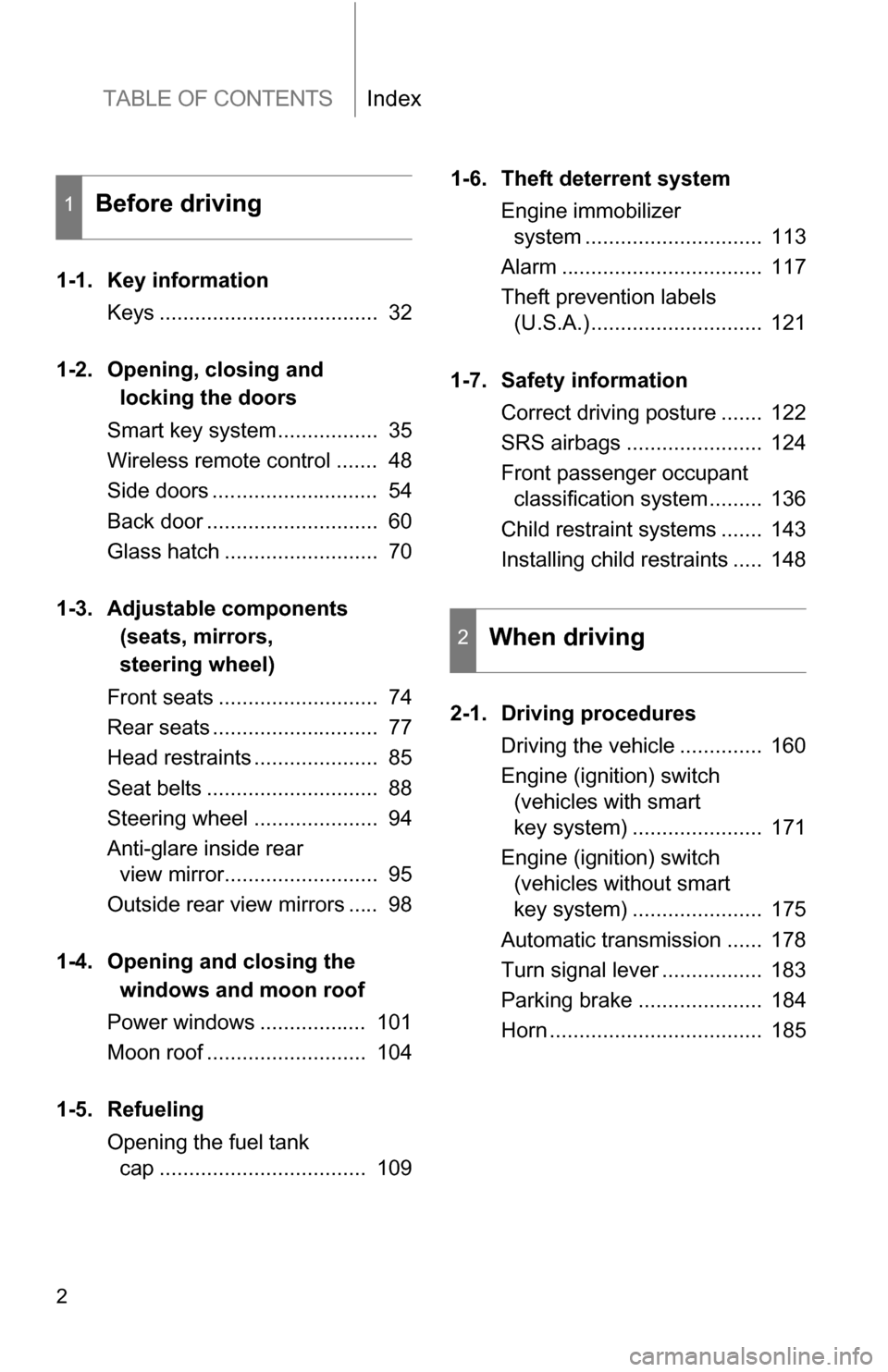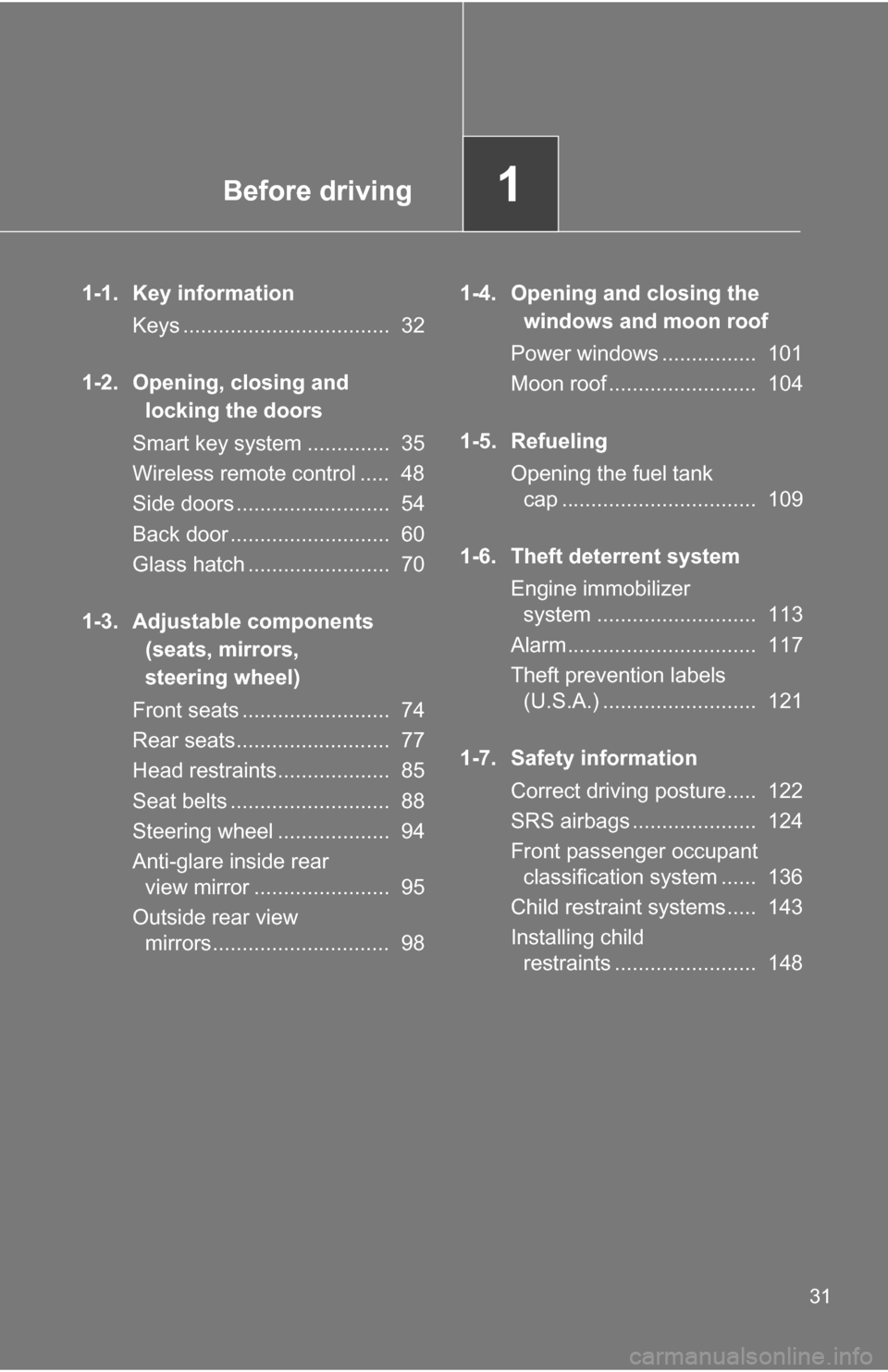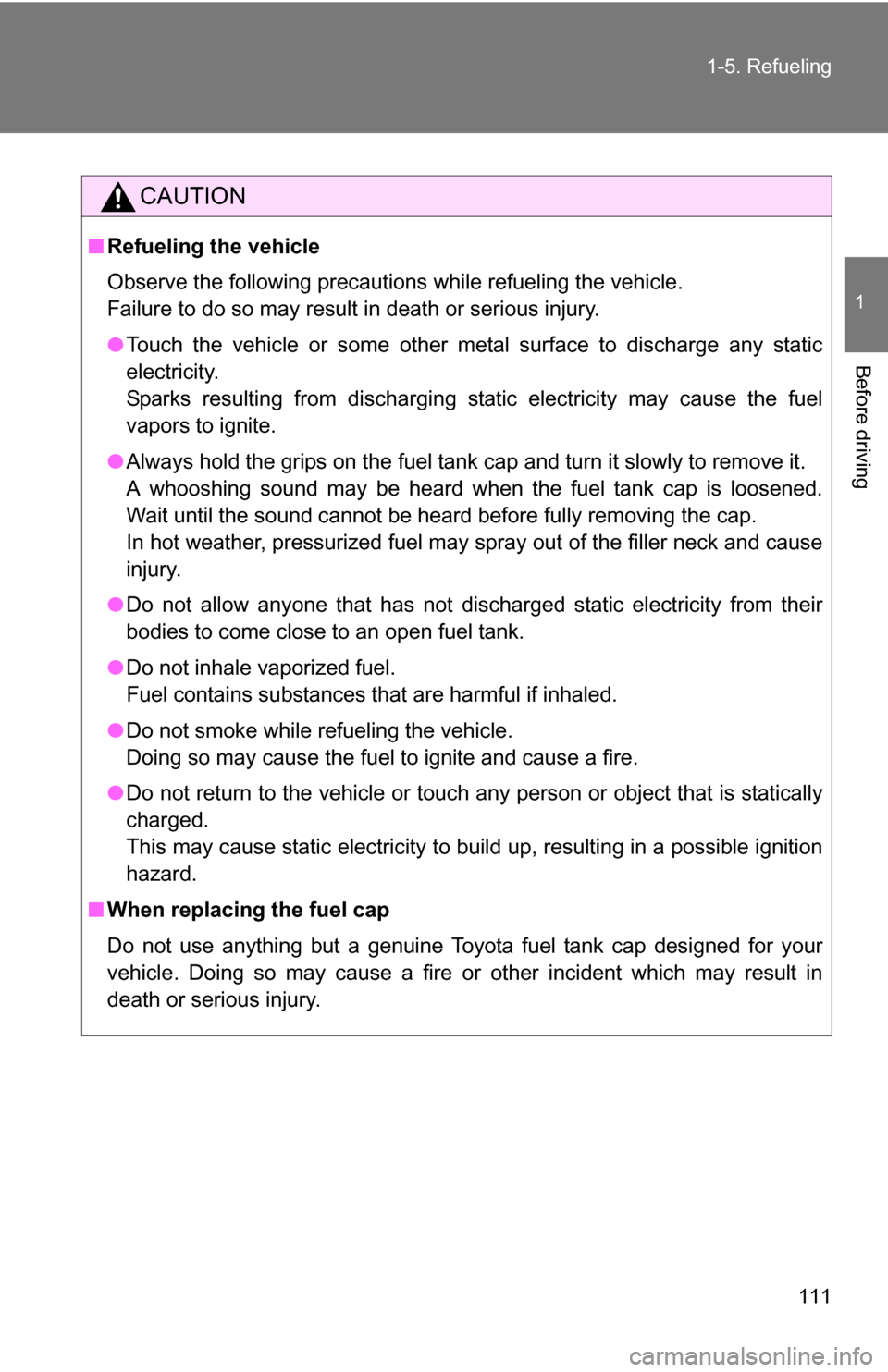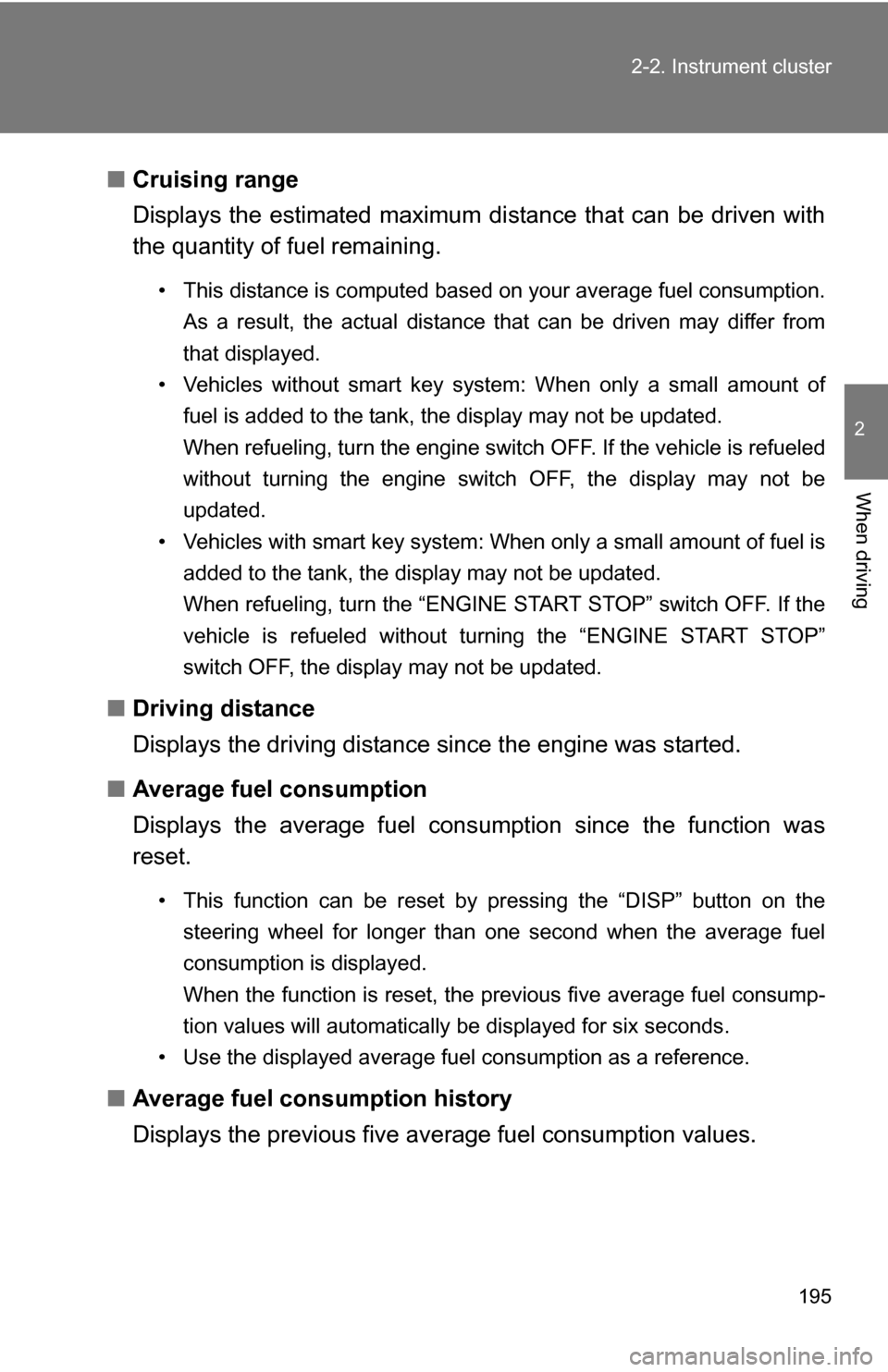Page 2 of 684

TABLE OF CONTENTSIndex
2
1-1. Key informationKeys ..................................... 32
1-2. Opening, closing and locking the doors
Smart key system................. 35
Wireless remote control ....... 48
Side doors ............................ 54
Back door ............................. 60
Glass hatch .......................... 70
1-3. Adjustable components (seats, mirrors,
steering wheel)
Front seats ........................... 74
Rear seats ............................ 77
Head restraints ..................... 85
Seat belts ............................. 88
Steering wheel ..................... 94
Anti-glare inside rear view mirror.......................... 95
Outside rear view mirrors ..... 98
1-4. Opening and closing the windows and moon roof
Power windows .................. 101
Moon roof ........................... 104
1-5. Refueling Opening the fuel tank cap ................................... 109 1-6. Theft deterrent system
Engine immobilizer system .............................. 113
Alarm .................................. 117
Theft prevention labels (U.S.A.)............................. 121
1-7. Safety information Correct driving posture ....... 122
SRS airbags ....................... 124
Front passenger occupant classification system ......... 136
Child restraint systems ....... 143
Installing child restraints ..... 148
2-1. Driving procedures Driving the vehicle .............. 160
Engine (ignition) switch (vehicles with smart
key system) ...................... 171
Engine (ignition) switch (vehicles without smart
key system) ...................... 175
Automatic transmission ...... 178
Turn signal lever ................. 183
Parking brake ..................... 184
Horn .................................... 185
1Before driving
2When driving
Page 31 of 684

Before driving1
31
1-1. Key informationKeys ................................... 32
1-2. Opening, closing and locking the doors
Smart key system .............. 35
Wireless remote control ..... 48
Side doors .......................... 54
Back door ........................... 60
Glass hatch ........................ 70
1-3. Adjustable components (seats, mirrors,
steering wheel)
Front seats ......................... 74
Rear seats.......................... 77
Head restraints................... 85
Seat belts ........................... 88
Steering wheel ................... 94
Anti-glare inside rear view mirror ....................... 95
Outside rear view mirrors.............................. 98 1-4. Opening and closing the
windows and moon roof
Power windows ................ 101
Moon roof ......................... 104
1-5. Refueling Opening the fuel tank cap ................................. 109
1-6. Theft deterrent system Engine immobilizer system ........................... 113
Alarm................................ 117
Theft prevention labels (U.S.A.) .......................... 121
1-7. Safety information Correct driving posture..... 122
SRS airbags ..................... 124
Front passenger occupant classification system ...... 136
Child restraint systems..... 143
Installing child restraints ........................ 148
Page 109 of 684
109
1
Before driving
1-5. Refueling
Opening the fuel tank cap
Perform the following steps to open the fuel tank cap.
■Before refueling the vehicle
Vehicles without smart key system
Turn the engine switch OFF and ensure that all the doors and
windows are closed.
Vehicles with smart key system
Turn the “ENGINE START STOP” switch OFF and ensure that
all the doors and windows are closed.
■ Opening the fuel tank cap
Open the fuel filler door.
Turn the fuel tank cap slowly
to open.
STEP1
STEP2
Page 110 of 684
110 1-5. Refueling
Closing the fuel tank capWhen replacing the fuel tank
cap, turn it until a clicking sound
is heard.
Once the cap is released, it will
turn slightly in the opposite direc-
tion.
Hang the fuel tank cap on the
back of the fuel filler door.STEP3
■Fuel types
Use unleaded gasoline. (Octane rating 87 [Research Octane Number 91] or
higher)
■ Fuel tank capacity
Approximately 19.2 gal. (72.5 L, 15.9 Imp. gal.)
Page 111 of 684

111
1-5. Refueling
1
Before driving
CAUTION
■
Refueling the vehicle
Observe the following precautions while refueling the vehicle.
Failure to do so may result in death or serious injury.
●Touch the vehicle or some other metal surface to discharge any static
electricity.
Sparks resulting from discharging static electricity may cause the fuel
vapors to ignite.
● Always hold the grips on the fuel tank cap and turn it slowly to remove it.
A whooshing sound may be heard when the fuel tank cap is loosened.
Wait until the sound cannot be heard before fully removing the cap.
In hot weather, pressurized fuel may spray out of the filler neck and cause
injury.
● Do not allow anyone that has not discharged static electricity from their
bodies to come close to an open fuel tank.
● Do not inhale vaporized fuel.
Fuel contains substances that are harmful if inhaled.
● Do not smoke while refueling the vehicle.
Doing so may cause the fuel to ignite and cause a fire.
● Do not return to the vehicle or touch any person or object that is statically
charged.
This may cause static electricity to build up, resulting in a possible ignition
hazard.
■ When replacing the fuel cap
Do not use anything but a genuine Toyota fuel tank cap designed for your
vehicle. Doing so may cause a fire or other incident which may result in
death or serious injury.
Page 186 of 684
186
2-2. Instrument cluster
Gauges and meters
Vehicles without smart key system
The following gauges and meters illuminate when the engine
switch is in the “ON” position.
Vehicles with smart key system
The following gauges and meters illuminate when the “ENGINE
START STOP” switch is in IGNITION ON mode.
Tachometer
Displays the engine speed in revolutions per minute.
Engine coolant temperature gauge
Displays the engine coolant temperature.
Fuel gauge
Displays the quantity of fuel remaining in the tank.
Speedometer
Displays the vehicle speed.
Odometer/trip meter switching and trip meter resetting button
Switches between odometer and trip meter displays. Pushing and hold-
ing the button will reset the trip meter when the trip meter is being dis-
played.
Page 195 of 684

195
2-2. Instrument cluster
2
When driving
■
Cruising range
Displays the estimated maximum di stance that can be driven with
the quantity of fuel remaining.
• This distance is computed based on your average fuel consumption.
As a result, the actual distance that can be driven may differ from
that displayed.
• Vehicles without smart key system: When only a small amount of fuel is added to the tank, the display may not be updated.
When refueling, turn the engine switch OFF. If the vehicle is refueled
without turning the engine switch OFF, the display may not be
updated.
• Vehicles with smart key system: When only a small amount of fuel is added to the tank, the display may not be updated.
When refueling, turn the “ENGINE START STOP” switch OFF. If the
vehicle is refueled without turning the “ENGINE START STOP”
switch OFF, the display may not be updated.
■Driving distance
Displays the driving distance since the engine was started.
■ Average fuel consumption
Displays the average fuel cons umption since the function was
reset.
• This function can be reset by pressing the “DISP” button on the
steering wheel for longer than one second when the average fuel
consumption is displayed.
When the function is reset, the previous five average fuel consump-
tion values will automatically be displayed for six seconds.
• Use the displayed average fuel consumption as a reference.
■ Average fuel consumption history
Displays the previous five av erage fuel consumption values.
Page 494 of 684

494
4-2. Maintenance
Emission inspection and maintenance (I/M) programs
Some states have vehicle emission inspection programs which
include OBD (On Board Diagnostics) checks. The OBD system moni-
tors the operation of th e emission control system.
■If the malfunction indicator lamp comes on
The OBD system determines that a problem exists somewhere
in the emission control system. Your vehicle may not pass the I/
M test and may need to be repaired. Contact your Toyota dealer
to service the vehicle.
■ Your vehicle may not pass the I/M test:
●When the battery is disconnected or discharged
Readiness codes that are se t during ordinary driving are
erased.
Also, depending on your driving habits, the readiness codes
may not be completely set.
● When the fuel tank cap is loose
The malfunction indicator lamp comes on as a temporary mal-
function and your vehicle may not pass the I/M test.
■ When the malfunction indicator lamp goes off after several
driving trips
The error code in the OBD system will not be cleared unless the
vehicle is driven 40 or more times.
■ If your vehicle does not pass the I/M test
Contact your Toyota dealer to prepare the vehicle for re-testing.